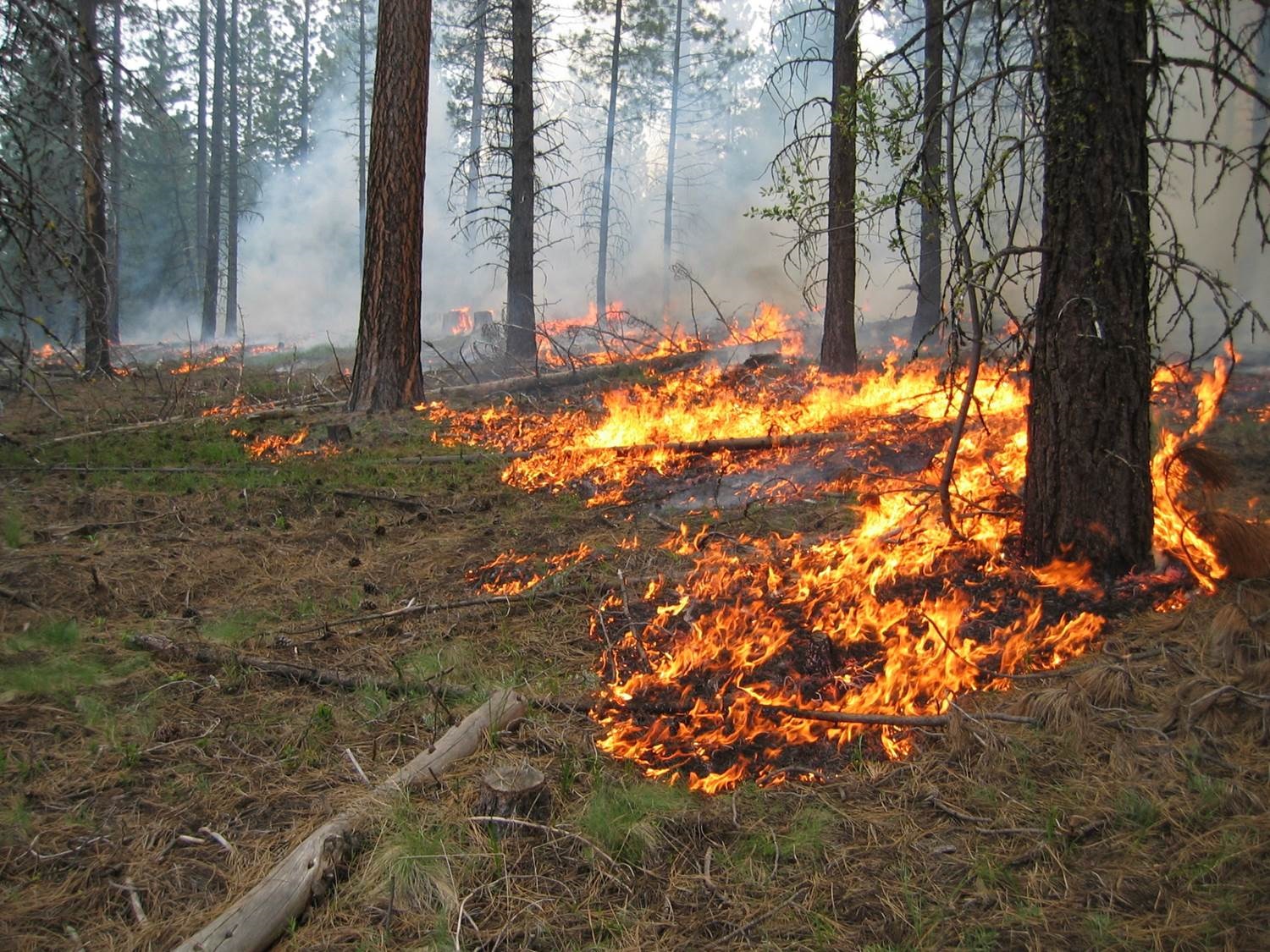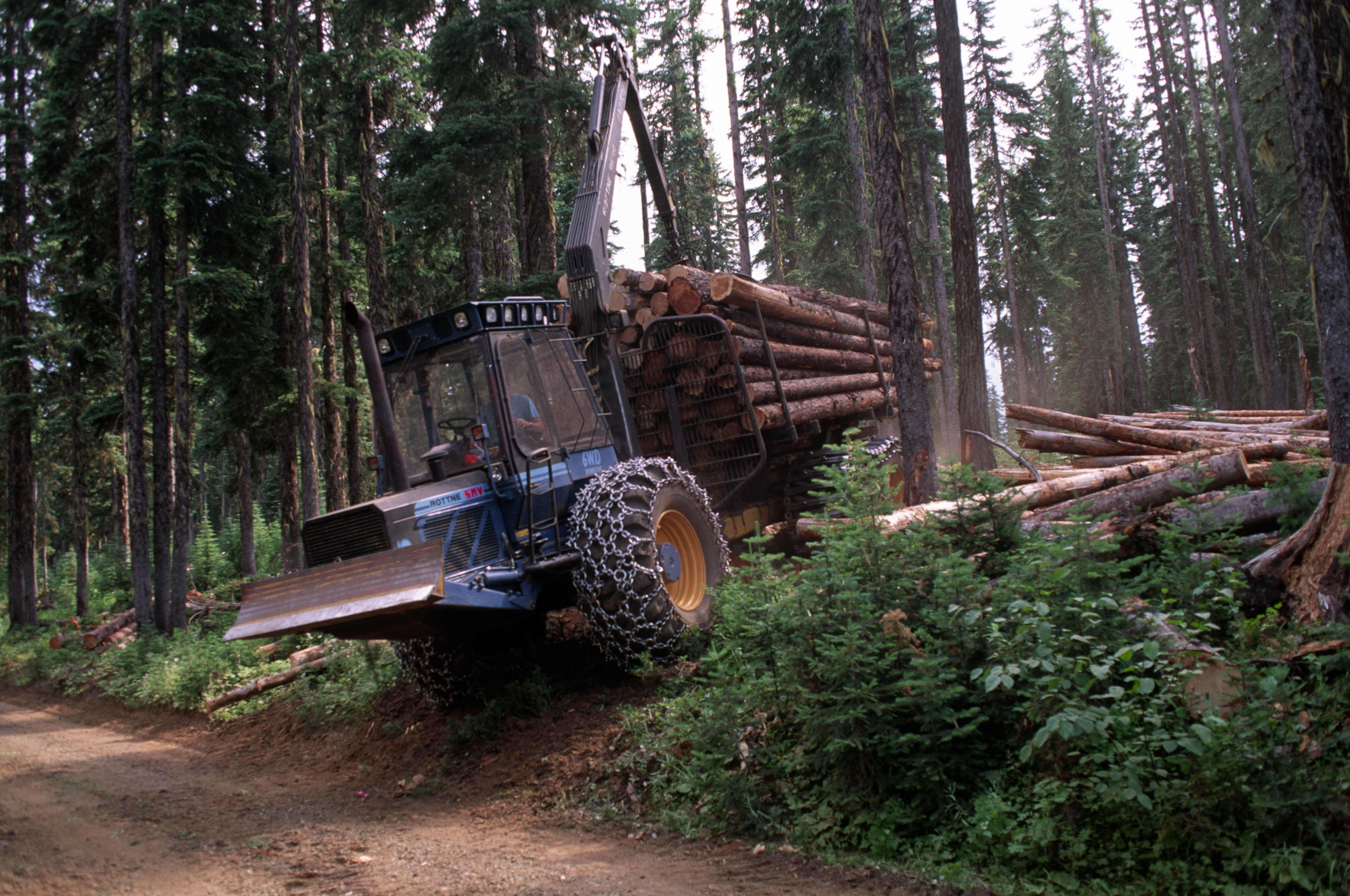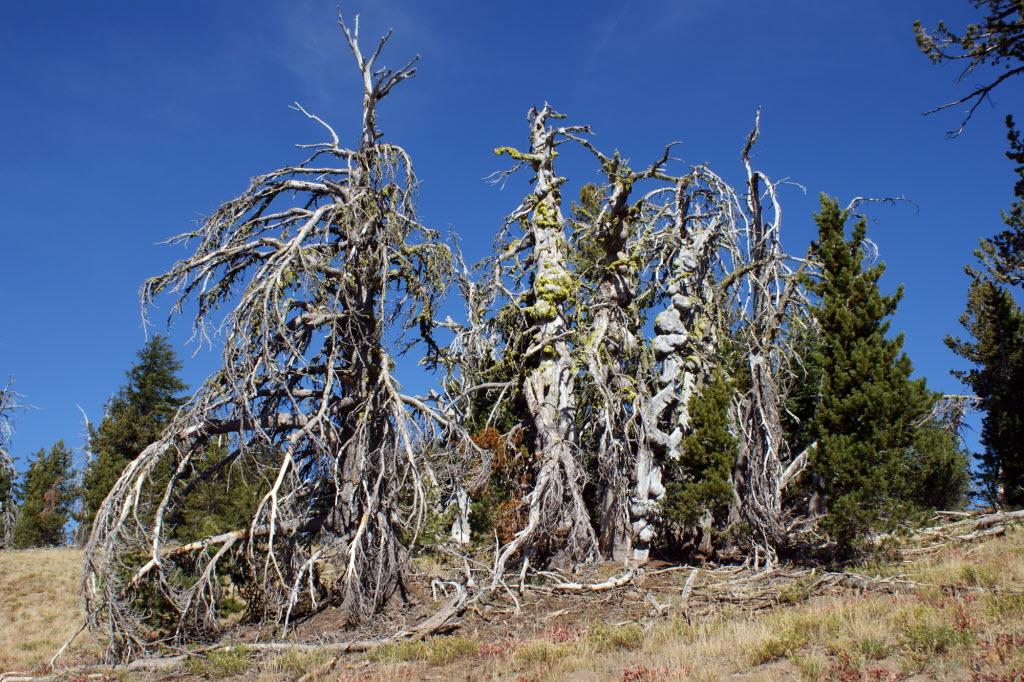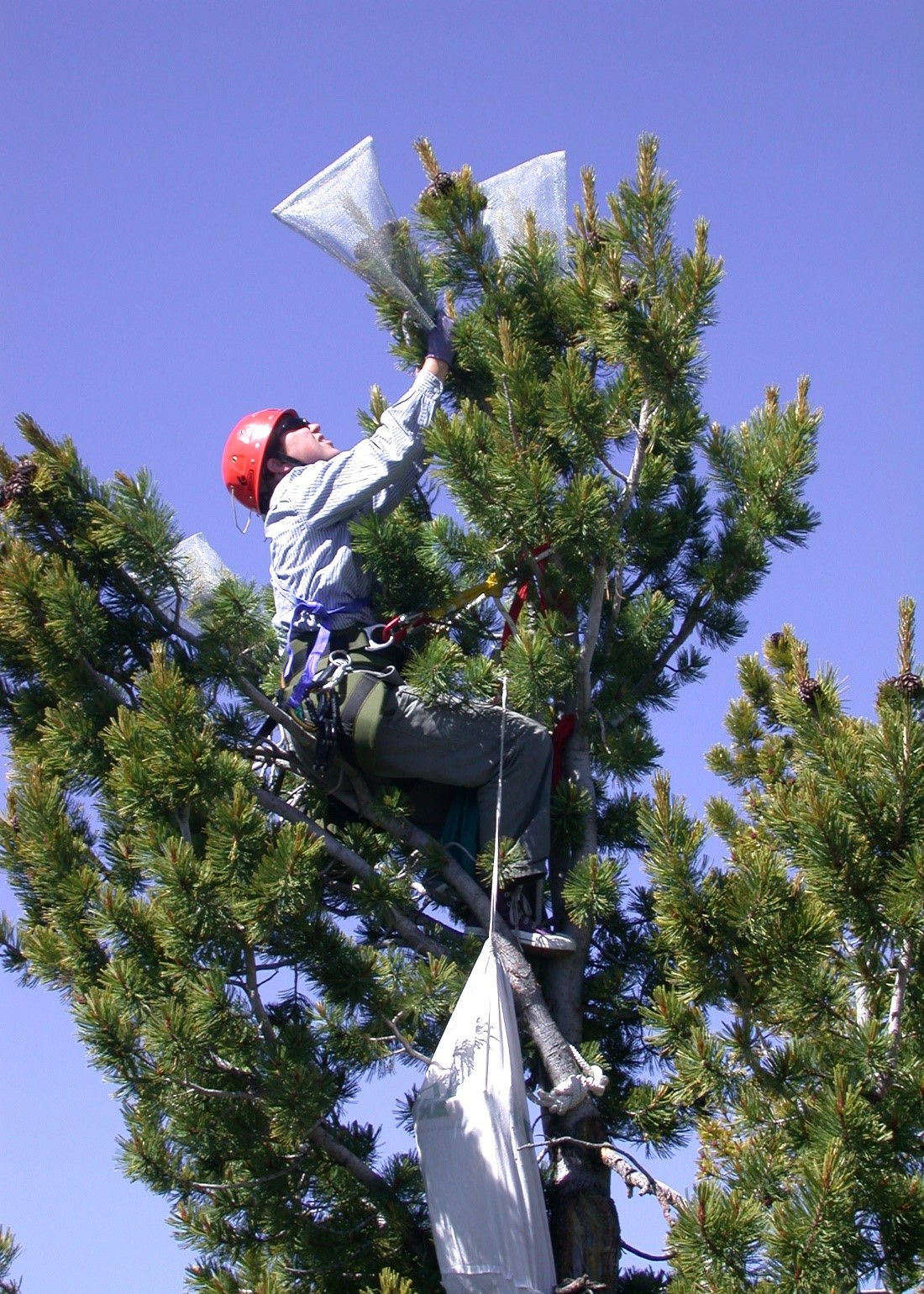Sensitivities
A. Warming temperatures will lead to longer fire seasons, increased wildfire frequency, and increased area burned across the western U.S.
B. There will be increased opportunity for invasive species establishment with increased disturbance and shifting plant species composition in a changing climate.
C. The potential for mortality events and regeneration failures will increase in a warming climate with increased fire, drought, insect outbreaks, and interactions among disturbances.
D. Warming temperatures will result in increased forest drought stress and decreased productivity, particularly at lower elevations.
E. Warmer conditions, and more fire, drought, and extreme events with climate change will increase tree susceptibility to and the potential for extensive insect outbreaks and possible spread of pathogens.
F. Higher temperatures will lead to changing vegetation dynamics in cold upland and subalpine forests.
G. Foliage fungi can cause more damage in warmer winter and warmer/wetter spring conditions.
H. Multiple factors, including white pine blister rust, bark beetles, and fire, will stress whitebark pine in a changing climate.
A. Sensitivity: Warming temperatures will lead to longer fire seasons, increased wildfire frequency, and increased area burned across the western U.S.
Explanation
Increasing temperatures will result in more fire (larger spatial extent and potentially more high-severity patches) (McKenzie et al. 2004, Westerling et al. 2006) and more area in recently burned or early-successional stages (Chmura et al. 2011).
Practices
Plan and prepare for greater area burned and longer fire seasons
- Continuously improve interagency coordination on fire management
- Create fuel breaks to protect communities and high-value habitats
- Anticipate more opportunities to use managed wildfire for resource benefit; in wilderness, permit fire to play a natural ecological role
- Identify processes and conditions that create durable fire refugia, and promote these processes and conditions to protect high-value habitats


Increase resilience of dry forest vegetation to fire by reducing forest density and hazardous fuels
- Conduct thinning to reduce high fuel concentrations, particularly in the wildland-urban interface
- Reduce fuel continuity and abundance of dwarf mistletoe fuel ladders
- Increase use of managed wildfire for resource benefit
- Use prescribed fire to maintain fire-resilient forest structure and promote fire-tolerant conifer species
Focus post-fire management on forest resilience
- Plan post-fire management response to large fires
- Conduct prompt post-disturbance regeneration assessments to accurately report reforestation needs and prescribe reforestation treatments and monitoring
- Update seed use plans to reflect increased reforestation needs at a regional scale with greater area burned
- Anticipate greater need for propagated plants for post-fire reforestation
- When planting trees post-disturbance, promote resilience to future conditions by considering fire tolerance and drought tolerance in planted species and genotypes
- Consider switching to autumn planting to increase survival and to take advantage of earlier soil warming in the spring
- Maintain key reforestation skills or arrange for training as needed on post-disturbance reforestation assessments (e.g., on seedling handling, cone and seed collection and handling, monitoring seedlings in storage, tree cooler maintenance and monitoring, microsite planting, reforestation contract administration)
- Understand past management history on reforestation sites and how it has influenced tree species composition (e.g., through selective logging) and may influence response to climate change
- Increase capacity to conduct tree survival assessments, and use findings to develop guidance for post-fire management
- Identify areas that were historically non-forested to eliminate areas for reforestation that are not likely to support forests in the future
- Increase post-fire monitoring to identify where regeneration failures are occurring and how vegetation trajectories may be changing
Maintain and restore species and structural diversity to increase ecosystem resilience to fire and increasing temperatures
- Manage for diversity of structure and patch size with fire and mechanical treatments to reduce fuel continuity and create more variation in fire behavior under average burning conditions
- Manage for late-successional forest conditions, as area of late-successional forest may decrease with increased area burned
- Use natural regeneration and planting of native species to promote diversity
- Plant and encourage regeneration of rare and disjunct species in appropriate locations
B. Sensitivity: There will be increased opportunity for invasive species establishment with increased disturbance and shifting plant species composition in a changing climate.
Explanation
Stand mortality following wildfire and insect outbreaks will increase open space, light, and nutrient availability that facilitate regeneration of both native and nonnative species (Hellmann et al. 2008), creating the potential for long-term change in species distribution and abundance that may or may not be consistent with land management objectives.
Practices
Increase invasive species control and prevention efforts
- Inventory regularly to detect new populations and species
- Implement early detection/rapid response for invasive species treatment
- Include invasive species prevention strategies in all projects
- Promote weed-free seed, straw, and hay
- Implement existing recommended management practices, such as restrictions on equipment and water use, when working in areas with root disease or other waterborne pathogens to prevent new infections and reduce spread
- Implement guidelines and restrictions on the movement of plant material to reduce the risk of introducing invasive species
- Educate employees, crews, and the public about invasive species and their detrimental effects on ecosystems
- Coordinate invasive species management, funding, and support among agencies and staff area
C. Sensitivity: The potential for mortality events and regeneration failures will increase in a warming climate with increased fire, drought, insect outbreaks, an interactions among disturbances.
Explanation
Permanently warmer temperatures and more frequent droughts create stress in mature trees, making them more susceptible to other stresses (e.g., insects). These conditions also make it difficult for newly germinated (or planted) trees to survive harsh conditions near the soil surface (Chmura et al. 2011, Clark et al. 2016).
Practices
Promote native species and genetic diversity appropriate to ecosystem and site constraints
- Maintain species diversity during thinning
- Work with geneticists to improve genetic diversity of regenerating trees where trees are being planted or where natural regeneration is prescribed
- Cautiously relax seed zone guidelines to include genotypes from warmer locations, develop monitoring protocols, and track their performance (unless empirical data from long-term provenance tests indicate otherwise, or negative effects on wildlife habitat may occur)
- Match species and seed sources to soil conditions
- Reduce competition (including herbicide use where appropriate) and promote desired species
- Develop systems to reliably track rare components of operational planting efforts over time (e.g., devise and implement systems to track trees from different seed zones)
Plan for large disturbances and mortality events
- Develop reforestation guidelines to ensure conservation of genetic, species, stand, and landscape diversity.
- Develop a gene conservation plan for ex situ collections for long-term storage
- Identify areas important for in situ gene conservation
- Maintain a tree-seed inventory with high-quality seed for a wide range of species, seed zones, and elevation bands
- Increase seed and propagule production of a wide variety of native plant species for post-disturbance restoration work
- Monitor reforestation success
D. Sensitivity: Warming temperatures will result in increased forest drought stress and decreased productivity, particularly at lower elevations.
Explanation
Even short drought periods can create stress and reduce growth, making trees more susceptible to other stressors (Clark et al. 2016).
Practices
Manage stand density to maintain tree vigor and increase resilience to drought
- Conduct thinning in dense forests to increase individual tree health and make trees more resilient to drought and more resistant to insect outbreaks
- Manage stands to reduce prevalence and impacts of dwarf mistletoe
- Use appropriately-timed girdling, cutting and leaving trees, prescribed burns, and managed wildfire to reduce stand densities and drought stress, yet provide standing dead trees to support beneficial microclimate and insect predators
- Maximize early-successional tree species diversity by retaining minor species during thinning activities to promote resilience to drier conditions
- Promote tree size and age diversity in stands and across large landscapes to increase resilience to insect outbreaks, fire, and drought; consider uneven-aged management
- Promote drought-tolerant species (e.g., in thinning prescriptions and planting), but not to the detriment of species diversity and habitat
- Use prescribed fire to reduce stand densities, increase landscape heterogeneity, and increase resilience to drought
- Monitor tree survival and growth under different management prescriptions
Develop capacity and guidance for drought preparedness and response
- Develop indicators for a “drought early warning system” for forests
- Leverage partnerships to increase capacity for mitigating and responding to drought
- Look for synergies that accomplish multiple objectives (e.g., use prescribed fire and thinning to increase drought resilience and achieve broader restoration goals)
- Institutionalize drought as a factor to be considered in existing guidance
E. Sensitivity: Warmer conditions, and more fire, drought, and extreme events with climate change will increase tree susceptibility to and the potential for extensive insect outbreaks and possible spread of pathogens.
Explanation
Insects and pathogens have high biological potential to reproduce and spread rapidly during periods of favorable environmental conditions (Weed et al. 2013). Many insect species, especially bark beetles, increase their populations rapidly in areas with stressed trees, potentially leading to outbreak conditions; some fungal pathogens also take advantage of stressed trees (Weed et al. 2013).
Practices
Increase resistance and resilience of forest stands to insects and pathogens
- Thin to decrease stand density and increase tree vigor
- Reduce density of post-disturbance planting
- Plant resistant species or genotypes where species-specific insects or pathogens are a concern
- Increase stand-scale biodiversity and prevent stand failure by planting multiple genotypes and multiple species (where appropriate)
- Promote age, size class, and structural diversity to increase resilience to insects and disease outbreaks
- Treat existing pathogen occurrence (e.g., dwarf mistletoe, root disease) more aggressively
- Strategically use anti-aggregation pheromones and protective pesticides to protect high-value trees and stands
- Increase the capacity to evaluate, recommend, and implement innovative forest protection strategies, and monitor effectiveness
F. Sensitivity: Higher temperatures will lead to changing vegetation dynamics in cold upland and subalpine forests.
Explanation
A warmer climate may alter species distribution and abundance in the long term, especially if large disturbances become more common; tree species and associated insects and pathogens that are energy limited may grow faster in some locations if they have a longer growing season (Halofsky and Peterson 2016).
Practices
Manage stem density and fuels in forests at lower elevations, thus reducing spread of large crown fires and dispersal of insect populations from lower-elevation forests
- Create targeted fuel breaks at strategic landscape locations
- Thin low-elevation dry forests to reduce fire intensity and spread into subalpine forest

- Thin low-elevation dry forest to reduce insect population pressure and spread into subalpine forests
Accelerate restoration of cold upland and subalpine forests, where appropriate
- Increase the availability of nursery stock and seed for tree species in cold upland and subalpine forests
- Plant and encourage regeneration of rare and disjunct species in appropriate locations
Monitor and detect change in survival, species composition, and mortality in subalpine forests
- Install and analyze additional monitoring plots to gather trend information over time, targeting areas where changes are expected
- Use existing monitoring information (e.g., Forest Inventory and Analysis plot information) to determine trends in subalpine forests
Identify and protect potential climate change refugia in cold upland and subalpine forests
- Map refugia
- Protect refugia from high-intensity fire by excluding fire, thinning, and using prescribed fire
- Control invasive plant species in high-elevation areas and potential refugia
- Monitor to determine where refugia are likely to exist under future conditions
G. Sensitivity: Foliage fungi can cause more damage in warmer winter and warmer/wetter spring conditions.
Explanation
Needle diseases are favored by warmer and wetter winters and springs, which may be more common with climate change (Sturrock et al. 2011). Needle casts, rusts, and needle blights in pines, Douglas-fir, and true fir usually cause loss of needles in the year following a season favorable for infection. Their occurrence at epidemic levels depends on favorable weather conditions and presence of an adequate host population (Sturrock et al. 2011).
Practices
Increase the capacity for evaluation and communication about rapidly-developing foliage symptoms.
- Improve access to foliage disease taxonomic identification
- Monitor foliage disease activity to assess whether long-term impacts are occurring
Use silvicultural techniques to reduce vulnerability
- Plant species that are compatible with local soils and climate
- Closely monitor diseases in trees planted for assisted migration (managed relocation)
- Increase species diversity in stands where possible
- Use techniques such as pruning to improve air circulation and reduce humidity in susceptible stands
H. Sensitivity: Multiple factors, including white pine blister rust, bark beetles, and fire, will stress whitebark pine in a changing climate.
Explanation
Whitebark pine populations are already reduced from white pine blister rust and bark beetles, and a warmer climate will promote the occurrence of mountain pine beetle at high elevation, as well as higher wildfire frequency, which may further stress whitebark pine (Keane et al. 2012).
Practices
Increase the competitive ability and resilience of whitebark pine to changing disturbance regimes
- Actively monitor and protect individual high-value whitebark pine trees (especially those with genetic resistance to white pine blister rust) with pesticides, pheromones, and other techniques
- Thin to reduce tree competition (e.g., remove whitebark pine or other species like subalpine fir)
- Regenerate rust-resistant strains and increase seed sources
- Create fuel breaks around whitebark pine individuals and stands
- Improve structural and age class diversity of whitebark communities at multiple scales
- Manage lower-elevation vegetation to reduce susceptibility to bark beetles and prevent outbreaks in whitebark pine stands
- Use the Minimum Requirements Decision Guide and the Evaluation Framework for Proposed Ecological Intervention and Restoration in Wilderness to evaluate site-specific proposals for actions in wilderness to support restoration of whitebark pine
Introduction Hydrology, Water Uses, and Infrastructure Forest Vegetation Non-Forest Vegetation
Riparian Areas, Wetlands, and Groundwater-Dependent Ecosystems Fish Habitat and Fisheries Wildlife Recreation References
Climate Risk Management Practices prepared by: J.J. Ho; J.E. Halofsky; D.L. Peterson

